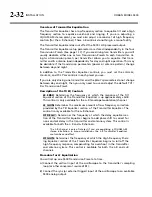
2-34
INSTALLATION ORBAN
MODEL
9400
frequencies might cause bounce and/or distortion on heavy bass tran-
sients in music. In step 15 on page 2-37, you will be instructed to turn the
L+R
LF
GN
control down until these problems are no longer observed.
This will make the measured square wave response poorer. However, en-
gineering realities force a compromise between best small signal (i.e.,
square wave) response and best large signal (i.e., bounce and distortion)
performance. This compromise is best made by careful experimentation
with program material to find the setting of the L+R LF GN control that
gives the highest average modulation without audible distortion.
J)
Adjust the
L+R
LF
FR
to make the square wave as flat as possible.
Work quickly to avoid overheating the transmitter.
Figure 2-10
shows the
result of a successful adjustment. If a display like that in
Figure 2-10
could
not be produced by adjusting the
LF
FR
control, transmitter low-
frequency response is inadequate and there is too much low-frequency
rolloff.
A transmitter that cannot be fully equalized can cost up to 4dB average
modulation even though audible frequency response does not suffer be-
cause equalization occurs below the audible frequency range. This prob-
lem cannot be corrected without modifying the transmitter. In many
cases, such modification is easy: it merely requires bypassing the highpass
filter(s) in the input stage of the transmitter. It also may require replacing
coupling capacitors with capacitors of a larger value. In other cases, fun-
damental inadequacies in the input, inter-stage transformers (if used),
and/or modulation transformers (if used) are the cause. See the discussion
on page 1-15.
Unless the transmitter is of a relatively modern solid-state design, being
unable to equalize it fully is a good reason to replace it with an up-to-
date solid-state design using a switching or digital modulator. In most
cases, this purchase will pay for itself in reduced power bills and the new
transmitter will sound far better on the air.
K)
Turn off the transmitter and allow it to cool down for several minutes.
13.
Equalize transmitter high-frequency response.
A)
Set the 9400's square wave controls to produce a 1 kHz square wave at 30%
modulation:
a)
Navigate to
S
ETUP
>
T
EST
.
b)
If necessary, set the
M
ODE
to
S
QUARE
.
c)
Set
S
QR
F
REQ
to
1000
H
Z
.
Note:
Because the 9400 is digital, its square wave generator cannot pro-
duce any harmonics higher than 16 kHz (one-half of its 32 kHz sampling
frequency). To prevent visible ringing of the square wave due to this
sharp cutoff of its higher harmonics, we have applied an internal digital
filter to the output of the 9400's square wave generator. This filter
rounds off the edges and prevents significant ringing. You may want to
look directly with the scope at the unequalized output of the 9400 to get
a feel for what this waveform looks like before it is applied to your
transmitter.
Summary of Contents for Optimod-AM 9400
Page 1: ...Operating Manual OPTIMOD AM 9400 Digital Audio Processor Version 1 2 Software...
Page 7: ...Operating Manual OPTIMOD AM 9400 Digital Audio Processor Version 1 2 Software...
Page 52: ......
Page 204: ......
Page 232: ......
Page 260: ......
Page 261: ...OPTIMOD AM DIGITAL TECHNICAL DATA 6 29...
Page 267: ...OPTIMOD AM DIGITAL TECHNICAL DATA 6 35 CPU Module...
Page 273: ...OPTIMOD AM DIGITAL TECHNICAL DATA 6 41 RS232 BOARD PARTS LOCATOR...
Page 275: ...OPTIMOD AM DIGITAL TECHNICAL DATA 6 43 8300 POWER SUPPLY PARTS LOCATOR...
Page 284: ...6 52 TECHNICAL DATA ORBAN MODEL 9400 DSP BOARD PARTS LOCATOR DRAWING 32170 000 14...
Page 292: ...6 60 TECHNICAL DATA ORBAN MODEL 9400 DISPLAY BOARD PARTS LOCATOR...
Page 293: ...OPTIMOD AM DIGITAL TECHNICAL DATA 6 61 DISPLAY BOARD...
















































